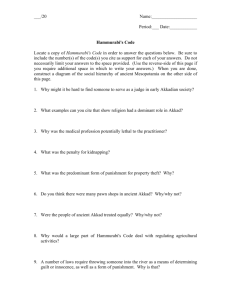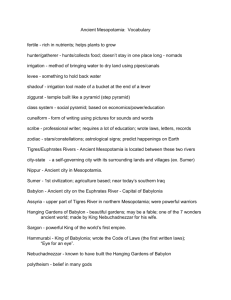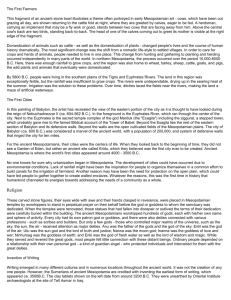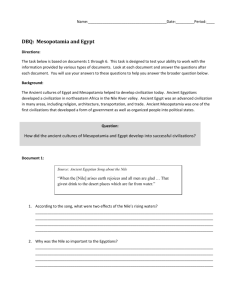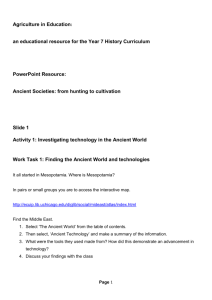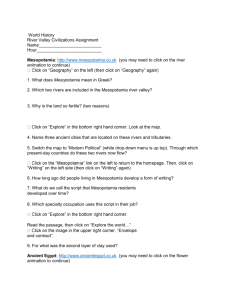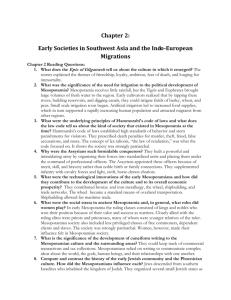File - Ms. Gerloski
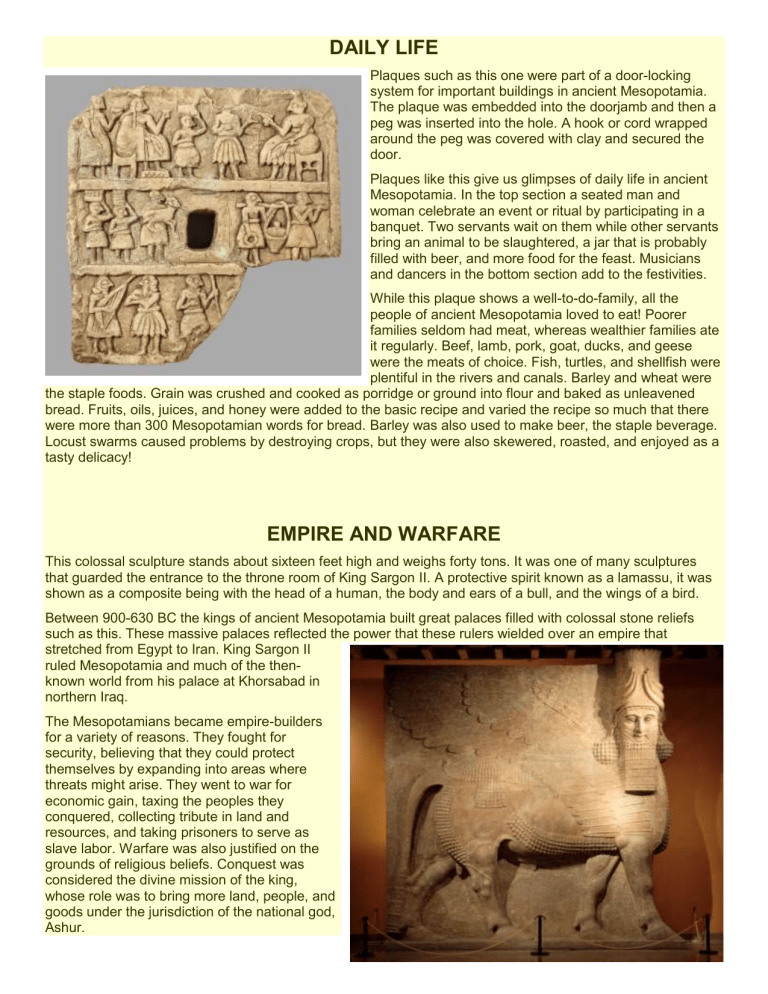
DAILY LIFE
Plaques such as this one were part of a door-locking system for important buildings in ancient Mesopotamia.
The plaque was embedded into the doorjamb and then a peg was inserted into the hole. A hook or cord wrapped around the peg was covered with clay and secured the door.
Plaques like this give us glimpses of daily life in ancient
Mesopotamia. In the top section a seated man and woman celebrate an event or ritual by participating in a banquet. Two servants wait on them while other servants bring an animal to be slaughtered, a jar that is probably filled with beer, and more food for the feast. Musicians and dancers in the bottom section add to the festivities.
While this plaque shows a well-to-do-family, all the people of ancient Mesopotamia loved to eat! Poorer families seldom had meat, whereas wealthier families ate it regularly. Beef, lamb, pork, goat, ducks, and geese were the meats of choice. Fish, turtles, and shellfish were plentiful in the rivers and canals. Barley and wheat were the staple foods. Grain was crushed and cooked as porridge or ground into flour and baked as unleavened bread. Fruits, oils, juices, and honey were added to the basic recipe and varied the recipe so much that there were more than 300 Mesopotamian words for bread. Barley was also used to make beer, the staple beverage.
Locust swarms caused problems by destroying crops, but they were also skewered, roasted, and enjoyed as a tasty delicacy!
EMPIRE AND WARFARE
This colossal sculpture stands about sixteen feet high and weighs forty tons. It was one of many sculptures that guarded the entrance to the throne room of King Sargon II. A protective spirit known as a lamassu, it was shown as a composite being with the head of a human, the body and ears of a bull, and the wings of a bird.
Between 900-630 BC the kings of ancient Mesopotamia built great palaces filled with colossal stone reliefs such as this. These massive palaces reflected the power that these rulers wielded over an empire that stretched from Egypt to Iran. King Sargon II ruled Mesopotamia and much of the thenknown world from his palace at Khorsabad in northern Iraq.
The Mesopotamians became empire-builders for a variety of reasons. They fought for security, believing that they could protect themselves by expanding into areas where threats might arise. They went to war for economic gain, taxing the peoples they conquered, collecting tribute in land and resources, and taking prisoners to serve as slave labor. Warfare was also justified on the grounds of religious beliefs. Conquest was considered the divine mission of the king, whose role was to bring more land, people, and goods under the jurisdiction of the national god,
Ashur.
Laws and Government
The Laws of Hammurabi are the longest and best organized of the law collections that survive from ancient Mesopotamia. King
Hammurabi, who ruled from 1792-1750 BC, had the laws inscribed on stone stelae which he placed in various temples throughout his realm. The stela from which this cast was made stands almost seven-and-a-half feet tall. At the top of the stela,
King Hammurabi stands before the sun god Shamash, the
Mesopotamian god of justice, who is seated on his throne.
Shamash gives Hammurabi the rod and ring, symbols of kingship and divine justice, thus reinforcing the ancient
Mesopotamian belief that laws came from the gods.
Below this scene is the law collection itself, mainly comprised of a compilation of legal verdicts describing specific offenses and the penalties to be enforced in particular situations. Preceding the law collection is a lengthy prologue, stressing the gods' appointment of Hammurabi as the ruler of his people.
Hammurabi's role was to act as guardian and protector of the weak and powerless, and to pay care and attention to the specific needs of the patron deities of the many cities incorporated into his realm. Following the laws is an epilogue stela and publicly displayed in order to testify to Hammurabi's righteous and just rule, to bring consolation to anyone seeking justice, and to serve as an example for future rulers. describing the king as the military leader who brings peace to his subjects. It explicitly states that these laws were inscribed on a
The First Cities
In the foreground of this picture is the Euphrates River, which ran through the center of the city. Next to the
Euphrates is the sacred temple complex of the god Marduk
(the "Esagila") including the ziggurat, a stepped tower, which probably gave rise to the famed Biblical account of the Tower of Babel. Beyond the Esagila lies the rest of the eastern section of Babylon and its defensive walls. Beyond the walls are the open cultivated fields of the
Mesopotamian plains. The city of Babylon around 600 BC was considered a marvel of the ancient world, with a population of 200,000, and a system of defensive walls that ringed the city for ten miles.
For the ancient Mesopotamians, their cities were the centers of life. When they looked back to the beginning of time, they did not see a Garden of Eden, but rather an ancient site called Eridu, which they believed was the first city ever to be created. Ancient Mesopotamia is where the world's first cities appeared around 4000 - 3500 BC.
No one knows for sure why urbanization began in Mesopotamia. The development of cities could have occurred due to environmental conditions. Lack of rainfall might have been the inspiration for people to organize themselves in a common effort to build canals for the irrigation of farmland. Another reason may have been the need for protection on the open plain, which could have led people to gather together to create walled enclaves. Whatever the reasons, this was the first time in history that humankind channeled its energies towards addressing the needs of a community as a whole.
